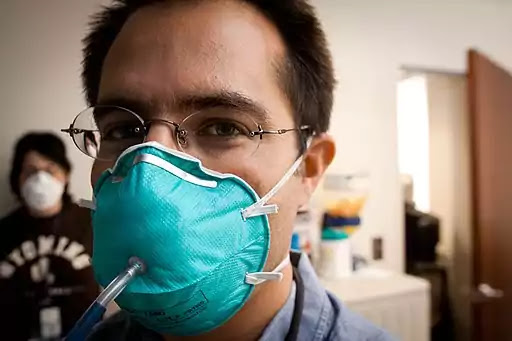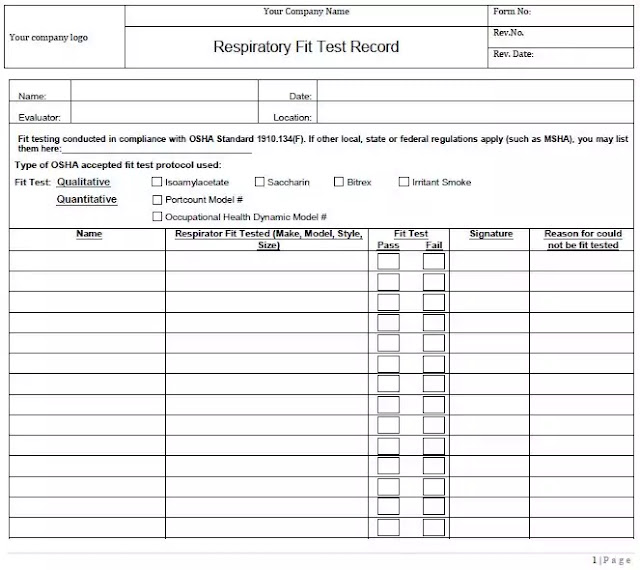Fit Testing | Respirator fit testing at the workplace
A respirator fit test shall be performed as a part of a written respiratory protection program to comply with OSHA standard requirements at the workplace.
 |
| Quantitative respirator fit test |
Respiratory Protection Program Requirement
According to OSHA, NIOSH and other standards recommendation, the employer shall establish and implement a written respiratory protection program with worksite-specific procedures.
In any workplace where respirators are necessary to protect the health of the employee or whenever respirators are required by the employer.
What is a respirator?
A device, which by function and design provides the user with an uncontaminated breathable source of air.
Types of respirators?
APR – Air Purifying Respirator. It is a respirator with an air-purifying filter, cartridge or canister that removes specific air contaminants by passing ambient air through the air-purifying element.
PDR – Pressure Demand Respirator. A positive pressure atmosphere- supplying respirator that admits breathing air to the facepiece when the positive pressure is reduced inside the facepiece by inhalation.
What is respiratory protection?
Respiratory protection means prevention from occupational diseases caused by breathing air contaminated with harmful dusts, fogs, fumes, mists, gases, smokes, sprays, or vapors, the primary prevention from contaminated atmospheric.
What is a fit test?
A “fit test” tests the seal between the respirator's facepiece and your face.
It takes about fifteen to twenty minutes to complete and is performed at least annually. After passing a fit test with a respirator, you must use the exact same make, model, style, and size respirator on the job.
How often is fit testing required?
The Fit test should be performed annually for each employee who using respirator during their job.
Who Needs Respirator Fit Testing?
The employees who are using the respirator to control occupational diseases caused by breathing air contamination have to undergo regular respirator fit testing.
What is the purpose of a respirator fit test?
The main purpose of a respirator fit test is to evaluate it is adequately fit on your face and contaminated air is not leaking into the respirator from external contaminated atmosphere.
A fit test should not be confused with a user seal check.
A user seal check is a quick check performed by the wearer each time the respirator is put on. It determines if the respirator is properly seated to the face or needs to be readjusted.
Types of respirator seal check.
There are two types of respirator seal check.
Positive Pressure Check –
Close off the exhalation valve and exhale gently into the facepiece. The face fit is considered satisfactory if a slight positive pressure can be built up inside the facepiece without any evidence of outward leakage of air at the seal.
Negative Pressure Check -
Close off the inlet opening of the canister or cartridge(s) with the palm of a hand, inhale gently so that the facepiece collapses slightly and hold breath for 10 seconds.
How many types of fit tests?
There are two types of fit tests.
1. Qualitative fit test.
2. Quantitative fit test.
Here is the video on Respiratory Fit Test Source by OSHA
Video used only for educational purposes.
Qualitative fit test
Qualitative fit testing is a pass/fail test method that uses your sense of taste or smell or your reaction to an irritant in order to detect leakage into the respirator facepiece.
Qualitative fit testing does not measure the actual amount of leakage. Whether the respirator passes or fails the test is based simply on you detecting leakage of the test substance into your facepiece.
There are four qualitative fit test methods accepted by OSHA:
1.Isoamyl acetate, which smells like bananas;
2.Saccharin, which leaves a sweet taste in your mouth;
3.Bittrex, which leaves a bitter taste in your mouth; and
4.Irritant smoke, which can cause coughing.
Qualitative fit testing is normally used for half-mask respirators - those that just cover your mouth and nose.
Half- mask respirators can be filtering facepiece respirators - often called "N95s" - as well as elastomeric respirators.
(Source from OSHA)
Quantitative fit test
Quantitative fit testing uses a machine to measure the actual amount of leakage into the facepiece and does not rely upon your sense of taste, smell, or irritation in order to detect leakage.
The respirators used during this type of fit testing will have a probe attached to the facepiece that will be connected to the machine by a hose.
There are three quantitative fit test methods accepted by OSHA:
1.Generated aerosol;
2.Ambient aerosol; and
3.Controlled Negative Pressure.
Quantitative fit testing can be used for any type of tight-fitting respirator.
Who can perform a respirator fit test?
Fit testing can be done by your employer or an outside party, including a union, an apprenticeship program, a contractor's association, or a past employer.
Your current employer is permitted to accept fit testing you have received from an outside party (such as a former employer) within the last 12 months, as long as you use the same respirator make, model, style, and size at your new worksite.
This is known as "fit testing portability." (Source by OSHA)
When to perform again fittest?
Whenever a different respirator facepiece is used by the employee or the employee reports or a Company Supervisory level personnel or Company physician makes a visual observation of changes in the employee’s physical condition that could affect respirator fit (i.e. facial scarring, dental changes, cosmetic surgery, and/or obvious changes in body weight).
What are the factors affecting to respirator?
Anything that comes between your face and respirator’s seal can affect the ability of respirator to protect such as facial hair, long hair, mustache, beard, additional PPE i.e. goggles, etc.
Respirator fit test form
Records of medical evaluations must be maintained in the employee’s confidential medical records.
Fit testing records containing the employee’s name, type of fit test performed, specific make, model, style, and size of respirator tested, date of test and indication of pass or fail status must be determined and kept on file.

Respiratory fit test Template
Conclusion
All employees should have to undergo through respiratory protection training prior to perform respiratory fit test.
The training content must be covered as follow but not limited to,
1. Identification and control measures of hazards during activity.
2. How to select respirator
3. How to wear respirator
4. How to conduct seal check
5. Cleaning and Inspection of respirator
6. Storage and care of respirator
7. Do's and Dont's
If you are seeking further information or any relevant help on the above topic, please feel free to contact us.
How many types of fit tests?
There are two types of fit tests.
1. Qualitative fit test.
2. Quantitative fit test.
Here is the video on Respiratory Fit Test Source by OSHA
Video used only for educational purposes.
Qualitative fit test
Qualitative fit testing is a pass/fail test method that uses your sense of taste or smell or your reaction to an irritant in order to detect leakage into the respirator facepiece.
Qualitative fit testing does not measure the actual amount of leakage. Whether the respirator passes or fails the test is based simply on you detecting leakage of the test substance into your facepiece.
There are four qualitative fit test methods accepted by OSHA:
1.Isoamyl acetate, which smells like bananas;
2.Saccharin, which leaves a sweet taste in your mouth;
3.Bittrex, which leaves a bitter taste in your mouth; and
4.Irritant smoke, which can cause coughing.
3.Bittrex, which leaves a bitter taste in your mouth; and
4.Irritant smoke, which can cause coughing.
Qualitative fit testing is normally used for half-mask respirators - those that just cover your mouth and nose.
Half- mask respirators can be filtering facepiece respirators - often called "N95s" - as well as elastomeric respirators.
(Source from OSHA)
Quantitative fit test
Quantitative fit testing uses a machine to measure the actual amount of leakage into the facepiece and does not rely upon your sense of taste, smell, or irritation in order to detect leakage.
The respirators used during this type of fit testing will have a probe attached to the facepiece that will be connected to the machine by a hose.
There are three quantitative fit test methods accepted by OSHA:
1.Generated aerosol;
2.Ambient aerosol; and
3.Controlled Negative Pressure.
Quantitative fit testing can be used for any type of tight-fitting respirator.
Who can perform a respirator fit test?
Fit testing can be done by your employer or an outside party, including a union, an apprenticeship program, a contractor's association, or a past employer.
Your current employer is permitted to accept fit testing you have received from an outside party (such as a former employer) within the last 12 months, as long as you use the same respirator make, model, style, and size at your new worksite.
This is known as "fit testing portability." (Source by OSHA)
When to perform again fittest?
Whenever a different respirator facepiece is used by the employee or the employee reports or a Company Supervisory level personnel or Company physician makes a visual observation of changes in the employee’s physical condition that could affect respirator fit (i.e. facial scarring, dental changes, cosmetic surgery, and/or obvious changes in body weight).
What are the factors affecting to respirator?
Anything that comes between your face and respirator’s seal can affect the ability of respirator to protect such as facial hair, long hair, mustache, beard, additional PPE i.e. goggles, etc.
Respirator fit test form
Records of medical evaluations must be maintained in the employee’s confidential medical records.
Fit testing records containing the employee’s name, type of fit test performed, specific make, model, style, and size of respirator tested, date of test and indication of pass or fail status must be determined and kept on file.
 |
| Respiratory fit test Template |
Conclusion
All employees should have to undergo through respiratory protection training prior to perform respiratory fit test.
The training content must be covered as follow but not limited to,
1. Identification and control measures of hazards during activity.
2. How to select respirator
3. How to wear respirator
4. How to conduct seal check
5. Cleaning and Inspection of respirator
6. Storage and care of respirator
7. Do's and Dont's
If you are seeking further information or any relevant help on the above topic, please feel free to contact us.

Nice Article .
ReplyDeleteYou can find more here----https://safetyofficer2020.blogspot.com/
Thanks for a wonderful share. Your article has proved your hard work and experience you have got in this field. Brilliant .i love it reading. FFP2 face mask
ReplyDeleteThank you sir for your positive gesture. It means a lot for me.
Delete